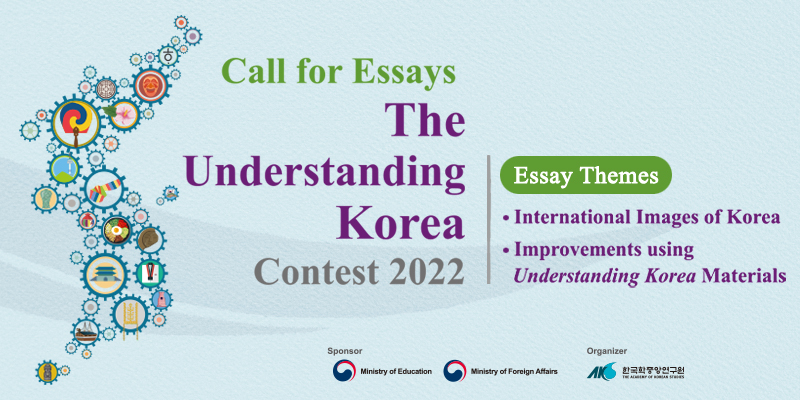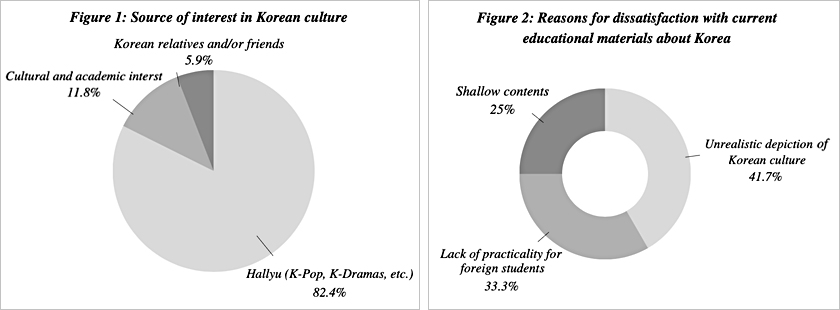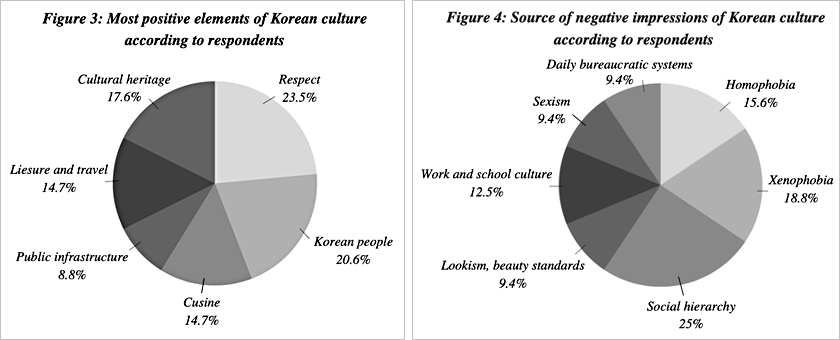Essay Contest Result

From the Outside Looking In: Foreigner-Oriented Approaches to Images of Korea
Introduction
Whereas the predominant images of Korea in the past have centered around war and nuclear threat, in recent decades South Korea has successfully cultivated a positive global image as a developed, democratic, and even 'hip' nation. Despite this, the 'images' of Korea abroad can be incomplete and inaccurate; as with any complex society, conveying 'Korea' through materials alone is a difficult task. For foreign audiences, educational and promotional materials often fail to fully capture their own direct encounters with Korea, and as a result, materials are in constant need of evolution and improvement. In this essay I will argue that international educational materials should adopt a twofold approach to improving current materials on Korean culture: first, they should provide a more integrated approach to Korean culture and society, and secondly, they should adopt multicultural and diversity as key elements of Korea's image.The research for this essay is based on 16 interviews (approx. 30~40 min. duration) with fellow colleagues in Korean studies, conducted both face-to-face and via Zoom. These respondents are all foreigners who have experience living and working in South Korea. I chose this demographic because those who interact with, study, and promote Korean culture function as an ambassadorial "bridge" between Korean society and the rest of the globe; moreover, they have detailed experience with Korean instructional materials and can provide firsthand feedback regarding their impressions of Korean culture through educational materials. The interview participants came from a large variety of backgrounds including those from North America (6), Europe (3), Southeast Asia (2), the Middle East (2), and South America (1). Interview responses were then formatted into graphs and charts to help visualize and summarize responses.
Toward Deeper Understandings of Korean Culture
Without a doubt, Korea's utilization of Hallyu as a key element of its image has been the most successful in spreading and promoting the image of South Korea abroad, especially with the rising popularity of global acts such as BTS (방탄) and Blackpink as well as Korean film/dramas like Parasite (2019) and Squid Game (2021). As a result of the efforts and collaboration between Korean government, tourist, and educational organizations, Korea has emerged as a new epicenter of "cool" and "youthful" culture. When looking at the data collected for this essay, Hallyu appears as the dominant force attracting the attention of foreigners worldwide; all 82.4% interview responses stated that interviewees were inspired to learn Korean language, move to Korea, and study about Korean culture due to their initial interest in K-Pop and K-Dramas (Fig. 1).
As it stands, however, this initial interest in Hallyu products does not always indicate that foreigners will maintain a wholly positive image of Korea. In fact, an over-reliance on Hallyu images may produce a disconnect or unfamiliarity with deeper aspects of Korean culture such as Confucian values, social hierarchies, work culture, and so on. When asked about how their interest and impressions of Korea has evolved, most respondents (13) expressed a desire to deepen their understanding of Korean culture by engaging it realistically through direct experience and attention to social issues while 3 reported a decline. One respondent Jess, when asked to give their general impression about Korean culture, responded, "Korean culture goes beyond what one can perceive through K-pop and K-dramas… Media and education materials often exclude other aspects such as respect towards elders, long work hours, and competitive education system." Another respondent Katelyn commented, "I gradually became more interested in Korean culture the more I watched Korean TV shows and listened to K-Pop… Later, I even studied abroad in South Korea myself which helped me experience Korean culture in a better, more realistic way rather than just through a TV screen."
In addition to developing an interest in the Korean lifestyle (language, food, etc.) and Korea's traditional cultural heritage, many respondents expressed a desire to engage with more nuanced and complex topics such as politics, social issues, etc. On this point, 25% of respondents (see Fig. 2) felt that current educational materials were lacking and contained only 'shallow' or simple vocabulary and topics. Respondent Iulia noted, "I do not think that a lot of these materials provide information for a deep understanding of Korean culture and society, such as politics or history… It is only possible to find these materials if you know what you are looking for." In this regard, I think that complex topics should be incorporated into educational materials so that a deeper understanding of Korean culture can be more accessible even to even beginner and intermediate learners. My central argument on this point is not that educators should disregard Hallyu contents as a source for learning about Korean culture; rather, I believe that educational and government organizations should strive to provide an integrated approach to generating images of Korea for foreign audiences. Specifically, they should adopt a hybridized strategy that translates Hallyu fans' interest in pop culture into a deeper understanding. For example, materials could take scenes or images from K-Pop as an introduction into other cultural elements such as hierarchy between members, idol work culture, Korean food, or even elements of traditional music, costume, etc and expand upon them.
Some positive aspects that respondents enjoyed about Korean culture are shown in the graphic below (Fig. 3), and these can serve as a starting point for integrated approaches to creating educational materials. As you can see, respondents enjoyed aspects such as respect and "jeong" between Korean people (44.1%); cultural heritage (17.6%); cuisine (14.7%); leisure and travel (14.7%); and public infrastructure (8.8%). However, as Kevi answered, these aspects so far have not been accurately depicted in Korean educational materials: "I would say that rather than using textbooks, learning it ourselves, seeing it, experiencing it depicts the culture more." Ashwin responded similarly, "I believe that in Korean language textbooks, not much is explained about Korean culture which actually leaves foreigners hanging on a cliff." Therefore, integrating hybrid images of fun popular culture, traditional culture, and complex social discussions should be paramount for building a comprehensive view of Korea for foreign audiences.
In addition to developing an interest in the Korean lifestyle (language, food, etc.) and Korea's traditional cultural heritage, many respondents expressed a desire to engage with more nuanced and complex topics such as politics, social issues, etc. On this point, 25% of respondents (see Fig. 2) felt that current educational materials were lacking and contained only 'shallow' or simple vocabulary and topics. Respondent Iulia noted, "I do not think that a lot of these materials provide information for a deep understanding of Korean culture and society, such as politics or history… It is only possible to find these materials if you know what you are looking for." In this regard, I think that complex topics should be incorporated into educational materials so that a deeper understanding of Korean culture can be more accessible even to even beginner and intermediate learners. My central argument on this point is not that educators should disregard Hallyu contents as a source for learning about Korean culture; rather, I believe that educational and government organizations should strive to provide an integrated approach to generating images of Korea for foreign audiences. Specifically, they should adopt a hybridized strategy that translates Hallyu fans' interest in pop culture into a deeper understanding. For example, materials could take scenes or images from K-Pop as an introduction into other cultural elements such as hierarchy between members, idol work culture, Korean food, or even elements of traditional music, costume, etc and expand upon them.
Some positive aspects that respondents enjoyed about Korean culture are shown in the graphic below (Fig. 3), and these can serve as a starting point for integrated approaches to creating educational materials. As you can see, respondents enjoyed aspects such as respect and "jeong" between Korean people (44.1%); cultural heritage (17.6%); cuisine (14.7%); leisure and travel (14.7%); and public infrastructure (8.8%). However, as Kevi answered, these aspects so far have not been accurately depicted in Korean educational materials: "I would say that rather than using textbooks, learning it ourselves, seeing it, experiencing it depicts the culture more." Ashwin responded similarly, "I believe that in Korean language textbooks, not much is explained about Korean culture which actually leaves foreigners hanging on a cliff." Therefore, integrating hybrid images of fun popular culture, traditional culture, and complex social discussions should be paramount for building a comprehensive view of Korea for foreign audiences.

Multicultural Korea: Improving Negative Images through Diversity
To understand specific areas where Korea could improve its image, I prompted interviewees to discuss what they find to be the most 'negative' aspects of Korean culture as found in their direct experiences and in educational materials. In doing so, this study found that most respondents not only experienced difficulty in their daily encounters with Korea as foreign visitors, but also that most respondents felt that Korean culture lacked dialogue on multiculturalism, diversity, and tolerance. This is of key importance to government and educational industries because the 'cool' brand Korea has thus far successfully developed can lose its appeal. For non-natives encountering unexpected culture shocks and discrimination, it can even become more difficult to rebuild once one develops negative impressions of Korean culture.As shown in figure 4, one core issue with foreigners' impressions of Korea lies in a lack of multicultural and diverse imagery. Respondents also reported issues with lookism, sexism, homophobia, and xenophobia in their impressions with and encounters with Korea, in addition to discomfort with competitive working/education environments and social hierarchy. Together, these responses can be summed up as a lack of diversity in approaches to images of Korea, especially for foreigners from multicultural backgrounds or those from minority groups such as Muslims, women, LGBTQ+, and people of color (black/Latinx). Interviewees were asked separately to comment on negative experiences they had directly in daily life or through textbooks, and in this regard xenophobia was the most common answer. One respondent Faith answered, "Although Korea is still very much more multicultural in the coming years, it still feels very homogeneous and a bit intimidating. Maybe because I was an African American, but sometimes people would treat me differently based on my appearance and make rude comments." Likewise, other interviewees reported experiences being turned away from businesses, or feeling an unwelcoming atmosphere. By reflexively acknowledging these potentially negative aspects and promoting more diverse images in educational materials, Korea can potentially mitigate negative images and affect change by promoting Korea as diverse and multicultural. By affecting change in the image of Korea, these materials can also lead.
In addition to those who encountered unexpected xenophobia, many people simply felt unprepared to experience daily life as a foreign resident. As discussed in the above section, most respondents felt that current materials were inadequate and shallow depictions of Korean culture. Moreover, 5 out of 16 respondents also felt that materials lacked practicality for the situations that foreign visitors often face. "When I came to Korea as part of a large effort by the Korean government's EPIK program, I was shocked by the lack of foreigner-friendly infrastructure to support us, especially in cities outside of Seoul," respondent Becca noted. "Websites, banks, businesses, and even the immigration offices will only speak to you in Korean and have systemic difficulties with foreign customers. I wish I had materials that had prepared me, and also that Korea could try to incorporate more foreigner-friendly institutions." In this regard, Korean educational materials should more accurately approach their target audience by incorporating diverse, multicultural images as well as addressing situations that foreigners may potentially face. Interviewee Alley summed up the issue with current materials, stating, "The negative aspects like xenophobia and sexism tend to be left out. Living in Korea vs reading about it in textbooks is very different, and it's very easy to feel isolated if you don't have the right resources as a foreigner."

